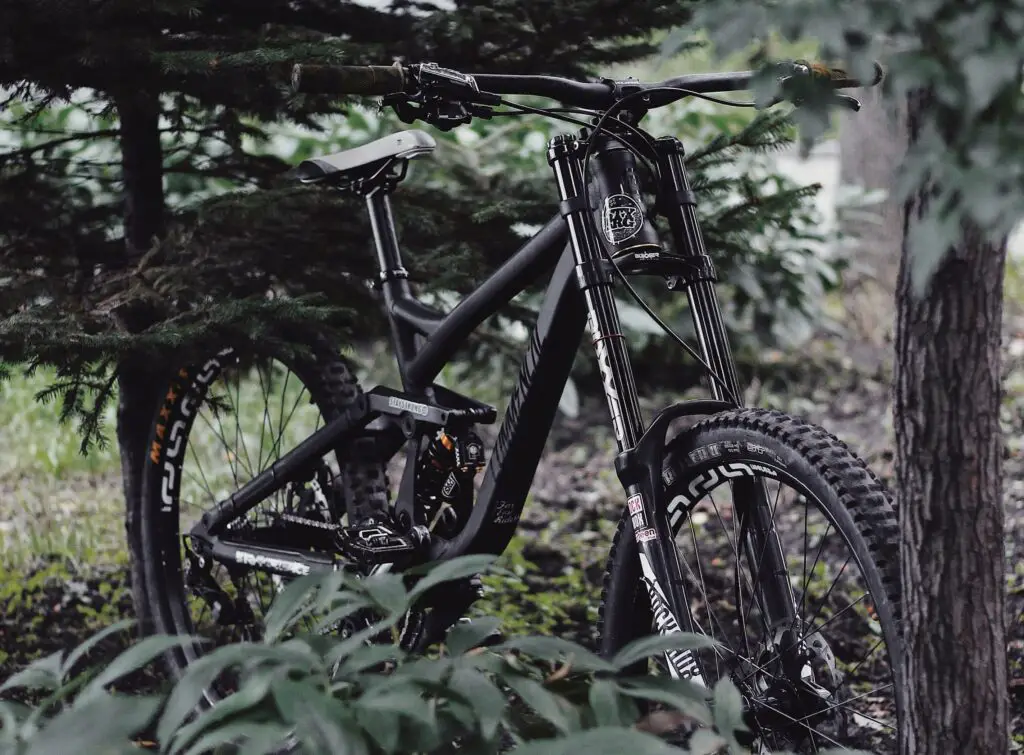Downhill bikes are the heaviest mountain bikes on the market. They typically weigh 35 – 40 pounds (15.9 – 18.1kg), with some bikes even pushing 45lbs+.
That’s extremely heavy when considering a typical trail bike weighs in at around the 30lbs mark (13.6kg). But what’s the reason for all this extra weight?
Keep reading to find out what makes downhill bikes so heavy, and why all that extra weight is necessary.
Here’s Why Downhill Bikes are So Heavy:
Downhill bikes are heavy due to their thick, long-wheelbase frames, heavy-duty suspension, large braking systems, and heavy-duty tires. The components listed are necessary for downhill bikes to give the strength, high degree of suspension, and stopping power required for downhill mountain biking.
Table of Contents

Downhill bikes are built to take punishment on the fastest, steepest trails with the gnarliest rock gardens, biggest drop-offs, and most terrifying jumps.
To top all of that off, downhill bikers can reach speeds of up to 50mph.
Combining those speeds with huge jumps and brutal technical features results in the need for a seriously robust bike with bucket loads of suspension and plenty of stopping power.
Here’s a quick summary of the features that make a downhill bike so heavy. Later we’ll look at each component in more detail, looking at examples of each component compared with other types of MTB.
- Downhill bike frames are heavier than other types of MTB frames as they need to deal with higher forces and impacts, as well as being relatively long.
- Suspension on downhill bikes is heavier. The rear suspension is bulkier and longer to provide more travel. The forks also have more travel and have a greater diameter than other types of MTB.
- Downhill bikes travel at very high speeds, so they need as much stopping power as possible. This means the brakes need to be large and robust.
- The wheels on a downhill bike are wider and stronger than other MTBs, making them heavier. Heavy-duty tires with thick treads and loads of grip add to the weight further.
Whilst all of these features are necessary for downhill riding, they make DH bikes pretty rubbish in most other circumstances. We did a detailed breakdown of why downhill bikes are a poor choice for trail riding in this article if you’d like to learn more.
In the following sections, we break each of the points above down in more detail and delve into comparisons of the key features of downhill bikes against trail bikes in order to better understand where all the extra weight comes from and why it’s necessary.
We chose trail bikes to compare with as they represent the ‘average’ all-purpose mountain bike.
Now let’s look at each of these components in more detail:
Downhill Bike Frames are Heavy
DH bikes have long wheelbases compared to other MTBs. We did our research for this article to compare the wheelbase length of a number of DH bikes from top manufacturers vs the wheelbase length of a typical trail bike.
Whilst the average chainstay length and reach of a downhill bike were virtually identical to those of the trail bikes we looked at as part of this analysis, the average wheelbase of a DH bike was 50.2 inches (1274.6mm) compared with 48.4 inches (1229.4mm) for the average trail bike.
This difference in wheelbase is due to the slacker head angle of DH bikes, averaging 62.9° vs that of the average trail bike with a 65.6° head tube angle.
The slacker head tube angle of DH bikes pushes the front wheel further forward.
That’s great for going downhill as it reduces the chance of the rider going over the bars and makes for a generally more comfortable and controlled ride on steep declines.
It also means a longer, and therefore, heavier frame.
On top of this, downhill bikes have thicker tubes that can withstand greater impact than other MTBs, which bumps up the frame weight even more as a result of the extra material used in the tubing.
Downhill Suspension is Heavy-Duty
DH bikes hit bigger jumps and drop-offs than other MTBs. They also tackle ruthless technical features at high speeds to an extent that trail bikes or even enduro bikes wouldn’t be able to manage.
This drives the need for suspension – bucket loads of suspension.

DH bikes have around 200mm of suspension travel front and rear, compared with 110mm – 150mm on a trail bike. This additional travel means longer forks and rear shocks, which of course means a heavier suspension system.
The additional length of the forks coupled with the slack head angle means there are more bending forces acting on the forks of a DH bike.
To counter these additional bending forces, DH bikes have thicker forks which again weigh more.
A DH bike will typically run with 40mm stanchion diameter forks, such as the Fox Factory 40 FIT Grip2, weighing in at 6.21lbs (2.82kg).
Trail bikes on the other hand don’t require forks this wide and typically opt for a 36mm option such as the Fox Factory 36 Float Performance, weighing in at 4.28lbs (1.94kg).
That’s a weight increase of almost 2lbs on the DH bike on forks alone.
Along with being both longer and thicker, DH forks have a double-crown, meaning they attach both above and below the head tube. This is another contributor to the top-end weight.
Downhill Bikes Have Big Breaks
As we’ve already discussed, DH riders will travel faster down steeper descents than in any other discipline. More speed and steeper trails mean more stopping power is needed to keep both the bike and the rider in one piece.
Every part of a downhill bike’s brakes is beefed up. They have bigger, heavy-duty calipers to provide more force to the rotor than you’d find on a trail bike.
On top of that the rotors, or discs, are bigger themselves. A trail bike would normally have a 160mm – 180mm brake disc. 200mm discs are standard on DH bikes. Again, bigger rotors = more material = heavier brake system.
Downhill Bikes Have Heavy-Duty Wheels & Tires
Downhill bikes have the widest rims and thickest tires of any MTB, if we take fat bikes out of the equation. Trail bikes and enduro will also run thick tires on occasion, but also have the option of choosing a lightweight set when necessary.
For downhill biking, a slick lightweight set of wheels is never required. The hardwearing rims and thick DH tires are another contributing factor to the weight of a DH bike.
